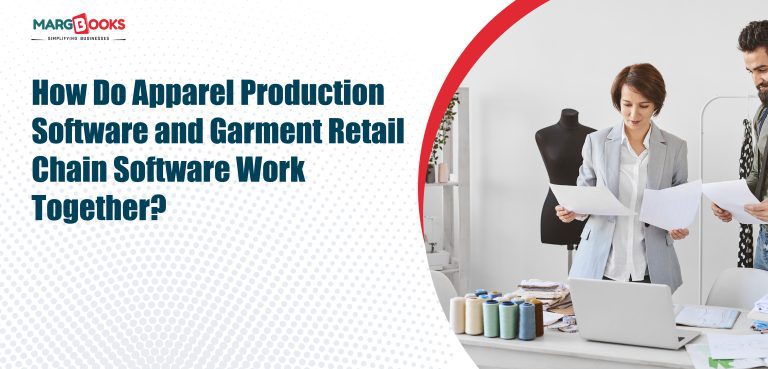Technology plays a crucial role in streamlining processes and ensuring a seamless journey from design to retail. Whether it’s a small boutique or a large-scale garment brand, managing operations efficiently is the key to staying ahead. This is where apparel production software and garment retail chain software come into play.
While these two systems serve different functions, they’re far more effective when they work in tandem. In this blog, we will walk you through how both software systems integrate and contribute to the overall success of a garment business, especially in the Indian market.
What is Apparel Production Software?
Simply put, apparel production software is designed to manage the entire lifecycle of garment manufacturing. From planning and designing to cutting, stitching, quality checks, and final packaging, it keeps every detail in check.
Key Features:
- Design and Tech Pack Management: Helps in storing all design specs, patterns, and material details.
- Material Requirement Planning (MRP): Ensures accurate procurement and usage of raw materials.
- Production Planning & Scheduling: Allocates time slots, manpower and machinery for efficient output.
- Inventory Tracking: Keeps a real-time count of fabrics, trims and finished goods.
- Costing & Budget Control: Assists in calculating production costs and maintaining budgets.
It’s basically the digital brain behind the physical operations of a garment manufacturing unit.
What is Garment Retail Chain Software?
Garment retail chain software, on the other hand, caters to the distribution and retail side of the fashion business. Whether you’re running a single store or a multi-location chain, this software helps manage sales, stock, purchases, returns, and customer data.
Features to Look For:
- POS (Point of Sale) Integration
- Multi-location Inventory Management
- Customer Relationship Management (CRM)
- Real-time Analytics & Sales Reporting
- GST-compliant Billing
One of the popular names in this category in the Indian market is MargBooks, known for its user-friendly interface and advanced retail chain solutions.
The Role of Garment Retail Chain Billing Software
In a high-volume retail environment, manually handling invoices or bills can quickly become chaotic. This is where Garment Retail Chain Billing Software makes a real difference. It automates the billing process, generates GST-compliant invoices, and helps in maintaining transparency in financials.
Benefits Include:
- Faster checkouts at retail counters
- Accurate tax calculations and filings
- Integration with inventory for real-time updates
- Easy return/refund management
- Customisable bill formats for branding
With MargBooks, you also get mobile support, cloud storage, and automated SMS/email alerts. The other features that make billing smarter and hassle-free.
How Do These Two Systems Work Together?
Now that we’ve understood the role of both systems, the real magic happens when they integrate and communicate seamlessly.
1. Inventory Coordination
The apparel production software keeps track of what’s being manufactured, while the garment retail chain software monitors what’s selling. When both are integrated:
- Retail demand can trigger automatic production planning
- Overstocking or understocking issues are eliminated
- Inventory levels are balanced across warehouses and stores
2. Faster Time-to-Market
The fashion industry thrives on trends. Integration ensures that new designs move quickly from production to retail.
- Real-time updates mean no delay in launching collections
- Faster restocking based on actual sales performance
3. Data-Driven Decision Making
Imagine having access to data from production, warehouse, and retail, all in one dashboard. That’s what this integration offers:
- Know which products are bestsellers
- Identify bottlenecks in production or sales
- Plan promotions and discounts effectively
4. GST and Financial Compliance
With software. MargBooks, financial operations across production and retail, are automatically synchronised:
- Purchase orders, bills, invoices, and payments are centrally logged
- Reduces human errors in taxation
- Helps in the accurate and timely filing of GST
5. Customer-Centric Retailing
Our Garment retail chain software captures data such as purchase history, preferences, and feedback. When this information is shared with the production team:
- Customisation becomes easier
- Popular sizes and styles are prioritised in production
- Better customer satisfaction and loyalty
Why Should Indian Garment Businesses Consider This Integration?
India’s fashion industry is vast, diverse, and deeply rooted in tradition. But as we adapt to digital tools, there’s a clear need to bring together different facets of garment production and retail.
Here’s why integration is especially beneficial in the Indian context:
- Managing a mix of offline and online retail models
- Coping with seasonal spikes in demand (like Diwali, Eid, or wedding seasons)
- Ensuring compliance with constantly changing GST norms
- Competing with fast fashion brands by reducing lead times
Conclusion
The synergy between apparel production software and garment retail chain software is no longer a luxury. It’s a necessity for businesses aiming for growth and scalability. Platforms such as MargBooks make it easier than ever to manage billing, inventory, and compliance across your retail chain while syncing perfectly with your backend production systems.
By adopting the right technology and ensuring these systems work in harmony, Indian garment businesses can not only improve productivity but also deliver a seamless experience to their customers.

